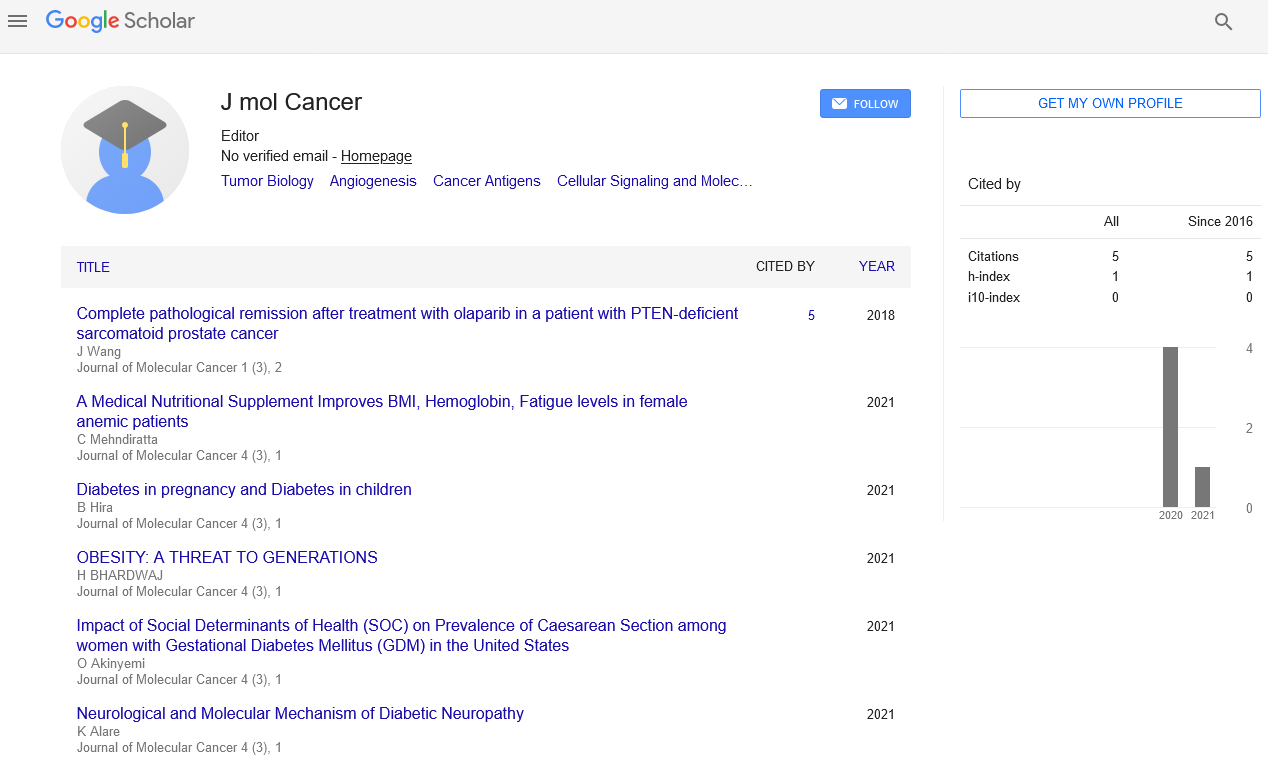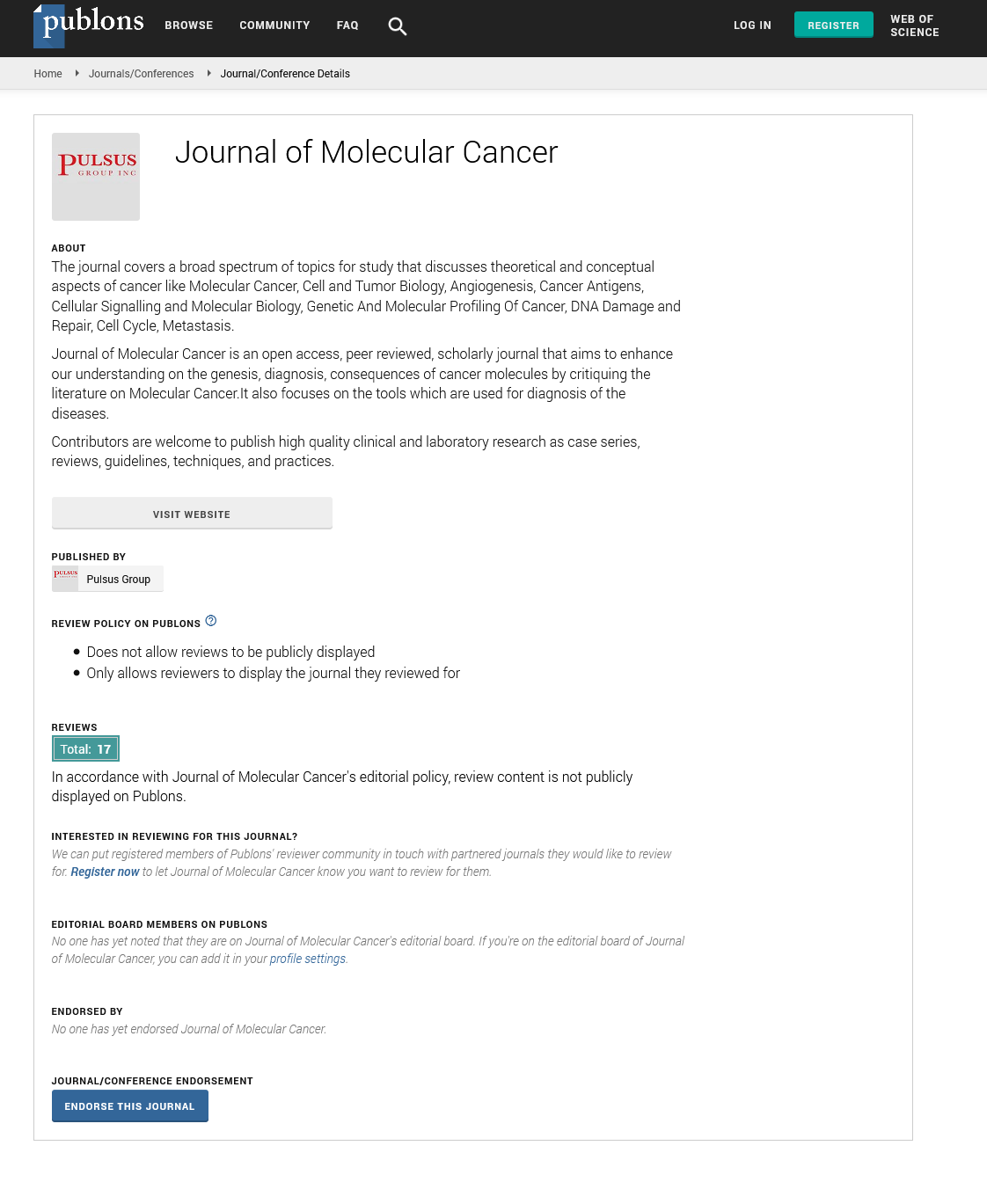Importance of assessing total vitamin B12 and active B12 levels in cancer patients
Received: 08-May-2018 Accepted Date: Jun 03, 2018; Published: 13-Jun-2018
Citation: Vira HJ. Importance of assessing total vitamin B12 and active B12 levels in cancer patients. J Mol Cancer. 2018;1(2):10-12
This open-access article is distributed under the terms of the Creative Commons Attribution Non-Commercial License (CC BY-NC) (http://creativecommons.org/licenses/by-nc/4.0/), which permits reuse, distribution and reproduction of the article, provided that the original work is properly cited and the reuse is restricted to noncommercial purposes. For commercial reuse, contact reprints@pulsus.com
Abstract
Cancer patients are immunocompromised due to the disease itself and also due to the weakness that ensue. The importance of measurements of Vitamin B12 levels has been increasingly implicated of which the measurements of active vitamin B12 have been given more importance. It also serves as an important coenzyme in various cellular processes such as regenerating methionine for protein synthesis, DNA synthesis, and DNA methylation.
Keywords
Cancer; Vitamin B12; active B12; Holotranscobalamin; Transcobalamin
Vitamin B12 deficiency has a worldwide prevalence. The vitamin B-12 concentrations in the plasma are a common occurrence in Indian population which may be attributed to the less dietary intake of animal related food products. The role played by malabsorption of vitamin-B12 in this is controversial [1]. Among the population groups at risk are older people, vegetarians, pregnant women and patients with renal or intestinal diseases [2]. Vitamin B 12 acts as a cofactor for two enzymes. It plays a crucial role in the synthesise of DNA, regenerating methionine for synthesis of proteins and their methylation, and also preventing the accumulation of homocysteine [3]. Plasma vitamin-B12 is bound by two poteins namely transcobalamin and haptocorrin. A minor amount of circulating vitamin B-12 is carried by transcobalamin and analysis has revealed that only 10% of the protein is saturated with vitamin B-12 [4]. Vitamin B-12 also known as holotranscobalamin (holoTC) is transported into all the cells of the body by transcobalamin resulting in the transport of approximately 4 nmol of vitamin B-12 every day [5]. However, the protein which is fully saturated with vitamin-B12 is Haptocorrin which is a glycoprotein of unknown function that helps in carrying major part of circulating vitamin-B12 and also carries the analogs of the vitamin which are in an inactive state. Haptocorrin metabolises slowly, with a turnover of 0.1 nmol vitamin B-12 every day [6–8].
The fact that only transcobalamin bound vitamin-B12 is available for cellular usage has given rise to the importance of assessing the holoTC as against the measurement of total vitamin-B12 i.e., all of the vitamin B-12 that binds to transcobalamin and haptocorrin [9]. In a study conducted in 93 German controls, 111 German and Dutch vegetarian subjects, 122 Syrian apparently healthy subjects, 127 elderly German’s it was observed that holotranscobalamin (holoTC), was the earliest marker for vitamin B-12 deficiency [10]. Due to the prevalence of low vitamin-B12 in human plasma among Indians which is possibly due to less intake of animal-source foods, the relationship of vitamin B12 and holotranscobalamin (holoTC) needs to be well established in healthy Indian population so as to serve as a referencing interval for studies on diseased population. This led us to perform a study in finding out the correlation between vitamin B12 and its active form holotranscobalamin in Indian cohorts. Aisari et al. conducted a random study in 76 patients for finding out the correlation of vitamin B12 and holotranscobalamin (holoTC) in Oman [11]. It was observed that there was a significant positive correlation (r=0.765, P<0.001) between holoTC and total vitamin B12. Accordingly, in 69 (90.8%) patients, there was a parallel agreement/ classification of results, both being normal or abnormal. Similarly a study conducted in elderly populations (age >60 years) indicated that measurement of both holoTC and total vitamin B12 provides a better screen for vitamin B12 deficiency than either assay alone [11]. Thus it is important to decipher the reference intervals of active vitamin B12 in normal healthy controls. Also in our on-going study on estimation of serum vitamin B12 levels in 750 normal healthy populations it was found that in males the reference range were 100-500 pg/ml and 113-481 pg/ml in females which is quite lower than the prevalent reference range (187-883 pg/ml). Hence, it would be beneficial to compare the levels of total vitamin B12 with the active vitamin B12 levels.
REFERENCES
- Bhat DS, Thuse NV, Lubree HG, et al. Increases in plasma holotranscobalamin can be used to assess vitamin B-12 absorption in individuals with low plasma vitamin B-12. J Nutr 2009;139:2119-23.
- Marker AE. Anaemia and haemoglobinuria Holotranscobalamin – An early marker for laboratory diagnosis of vitamin B12 deficiency. Anaemia and Haemoglobinuria 2009;7-11.
- Miller JW, Garrod MG, Allen LH, et al. Metabolic evidence of vitamin B-12 deficiency, including high homocysteine and methylmalonic acid and low holotranscobalamin, is more pronounced in older adults with elevated plasma folate. Am J Clin Nutr 2009;90:1586-92.
- Nexo E, Andersen J. Unsaturated and cobalamin saturated transcobalamin I and 11 in normal human plasma. 1977;723-8.
- Hom BL, Olesen HA. Plasma clearance of 57cobalt-labelled vitamin B12 bound in vitro and in vivo to transcobalamin I and II. Scand J Clin Lab Invest 1969;23:20111.
- Nexo E, Gimsing P. Turnover in humans of iodine- and cobalamin-labeled transcobalamin I and of iodine-labeled albumin. 1975;35:391-8.
- Van der Westhuyzen J, Fernandes-Costa F, Metz J, et al. Cobalamin (vitamin B12) analogs are absent in plasma of fruit bats exposed to nitrous oxide. Proc Soc Exp Biol Med 1982;171:88-91.
- Hardlei TF, Nexo E. A new principle for measurement of cobalamin and corrinoids, used for studies of cobalamin analogs on serum haptocorrin. Clin Chem 2009;55:1002-10.
- Nexo E, Hoffmann-lu E. Holotranscobalamin, a marker of vitamin B-12 status : analytical aspects and clinical utility 1 – 5. Am So 2011;1-7.
- Herrmann W, Obeid R, Schorr H, et al. Functional vitamin B12 deficiency and determination of holotranscobalamin in populations at risk. Clin Chem Lab Med 2003;41:1478-88.
- Al-Aisari F, Al-Hashmi H, Mula-Abed WA. Comparison between serum holotranscobalamin and total vitamin B12 as indicators of vitamin B12 status. Oman Med J 2010;25:9-12.






